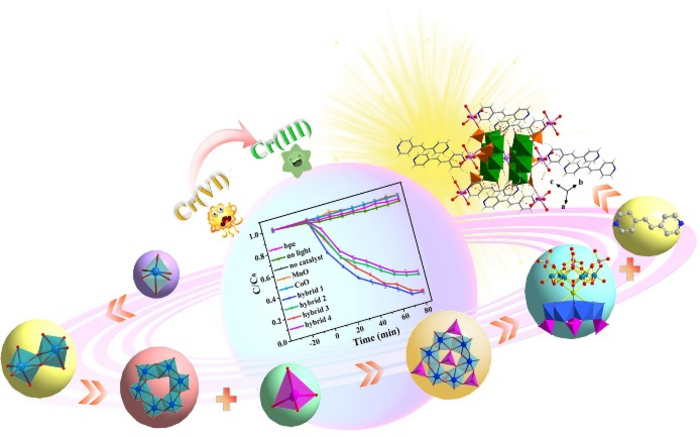Reviewed by Alex SmithMar 31 2023
Toxic heavy metals detected in wastewater pose health and safety problems for communities affected by pollution. Hexavalent chromium is a carcinogenic by-product of industrial processes that have been associated with birth abnormalities, severe diarrhea, and kidney, bladder, and liver malignancies. It was famously the subject of the lawsuit depicted in the film “Erin Brockovich.”

The graph in the center of this image shows the hybrid photocatalysts, labeled as 1 through 4, and the stark reduction in hexavalent chromium in the research when compared to other photocatalysts. Image Credit: Polyoxometalates, Tsinghua University
Investigators are attempting to find effective methods of removing hexavalent chromium from wastewater, and recently published research demonstrates how photocatalytic technology may be a solution. Photocatalysis is the use of light plus a catalyst to accelerate chemical reactions.
On March 23rd, 2023, the paper was published in Polyoxometalates.
Rapid industrialization causes an increased release of wastewater containing heavy metal ions. Hexavalent chromium, which has high carcinogenicity and teratogenicity, is widely found in wastewater and can easily enter food chains.
Yuan-Yuan Ma, Researcher, Hebei Normal University
Since it is sustainable, cost-effective, and environmentally friendly, photocatalysis technology is an enticing solution for eliminating heavy metals from wastewater.
This green approach for the removal of heavy metal ions uses sustainable light energy via hourglass-type phosphomolybdate-based crystalline photocatalysts and develops a strategy for the regulation of photocatalytic performance by adjusting the central metal ions in hourglass-type phosphomolybdate clusters.
Yuan-Yuan Ma, Researcher, Hebei Normal University
Investigators selected this type of photocatalyst because of its molecular characteristics and well-defined hourglass-type structure, which provide it a wide light absorption ability as well as the band structure required to reduce hexavalent chromium levels.
Four “hybrid” photocatalysts were evaluated and compared to six other photocatalysts. The hybrids had slightly varying compositions, but they all had the same hourglass-type structure that could withstand temperatures of up to 200 ºC.
They had wide visible-light absorption and similar energy band structures. Researchers labeled these as Hybrid 1, 2, 3, and 4. After 80 minutes of exposure to a 10 W LED light, hybrids 1 and 3 had approximately a 90% reduction in hexavalent chromium, whereas hybrids 2 and 4 had approximately a 74% and 71% reduction in hexavalent chromium, respectively.
The hybrids outperformed all the tested photocatalysts. Both hybrids 1 and 3, which performed best, were Mn{P4MO6}2-based hybrids. Hybrids 2 and 4 were Co{P4MO6}2-based. The better performance might be due to the structural variations, which could have given hybrids 1 and 3 a reduced band gap.
The semiconductor photocatalysts in photocatalytic processes can absorb photons matched with their band gap energy, leading to the conversion of toxic hexavalent chromium to less toxic chromium.
Yuan-Yuan Ma, Researcher, Hebei Normal University
Scientists intend to optimize the photocatalyst design while also considering how to effectively apply this technology in a real-world wastewater setting.
Ma adds, “Designing effective photocatalysts is the first step to solve heavy metal pollution in water. We will design more efficient photocatalysts and apply the developed photocatalysts to actual industrial wastewater. We will also expand the treatment range of polluted water sources and strive to realize the practicality of the photocatalyst materials used.”
Xiao-Yu Yin, Hao-Xue Bi, Hao Song, Jing-Yan He, Ting-Ting Fang, and Zhan-Gang Han of Hebei Normal University contributed to the research
The research was funded by the National Natural Science Foundation of China, the Science and Technology Project of Hebei Education Department, the Natural Science Foundation of Hebei Province, the China Postdoctoral Science Foundation Funded Project, the Science Foundation of Hebei Normal University, the Innovation Capability Improvement Plan Project of Hebei Province, and the College Student Science and Technology Innovation Project of Hebei.
Journal Reference:
Yin X-Y, et al. (2023) Photoactive hourglass-type M{P4Mo6}2 networks for efficient removal of hexavalent chromium. Polyoxometalates. doi.org/10.26599/POM.2023.9140027.